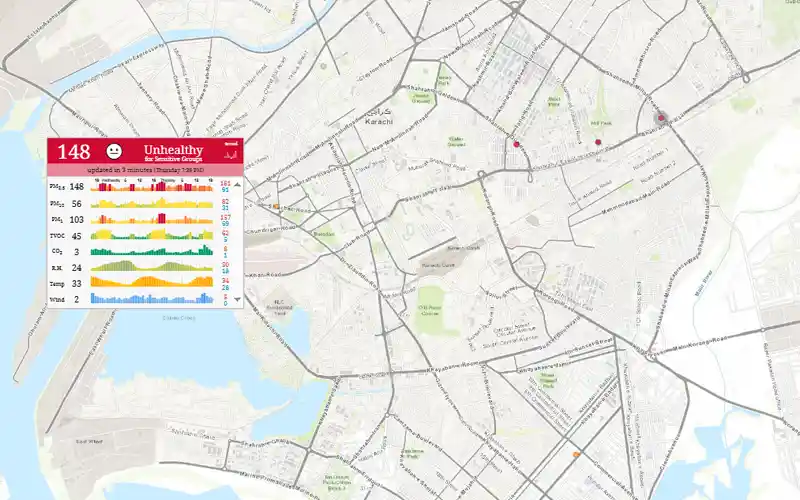The levels of air quality remained unhealthy in Karachi, raising serious health concerns, according to the latest air quality index report updated Thursday at 7:57 PM.
The latest air monitoring reports recorded PM2.5 concentrations ranging between 108 and 151 micrograms per cubic meter in different areas across Karachi.
These air quality levels are categorized as hazardous for sensitive groups such as children and elderly citizens.
The highest PM2.5 reading of 151 was recorded at Climate Action Center, Jamshed Town, indicating poor air quality in the city’s busiest commercial corridor.
In Keamari Town, the PM2.5 level at the Solid Waste Management site is recorded at 117, which, while elevated, remains lower compared to other parts of the city.
In Karachi District, the G3 Engineering Consultants area reports a PM2.5 level of 118. Saddar Town is also experiencing poor air quality, with DG House DHA 5 at 122, Zafar Memon DHA at 110, and NED University City Campus at 148.
To stay informed about current Karachi Air Quality, visit TOK Weather Page
The Climate Action Center in Jamshed Town recorded a PM2.5 level of 166, followed closely by the Urban Unit at 160 and the Urban Resource Center at 161.
In Gulshan-e-Iqbal Town, Aga Khan University’s Main Campus reported a PM2.5 level of 138, while its IED campus measured 130.
Asif Gulistan-e-Johar in the Gulshan District showed a PM2.5 level of 152. Other monitoring points in Gulshan-e-Iqbal, including NED University and the University of Karachi’s Institute of Space Science and Technology, recorded 117 and 119, respectively.
In North Nazimabad Town, the PM2.5 level at Aman Khan Kaka Khail stood at 153. Meanwhile, the Orangi Pilot Project in SITE Town reported a PM2.5 reading of 140.
These figures highlight a worrying trend in Karachi’s air quality, emphasizing the urgent need for targeted environmental and public health interventions.
How many categories are there to measure Air Quality?
AQI 0–50: Good
The air quality is considered excellent, with minimal or no risk to public health. There are no necessary precautions for the general population.
AQI 51–100: Moderate
Air quality is generally acceptable; however, there may be a slight health concern for a small number of individuals who are unusually sensitive to air pollution. Active children, adults, and people with respiratory conditions like asthma should consider limiting prolonged outdoor activity.
AQI 101–150: Unhealthy for Sensitive Groups
Sensitive individuals, such as those with asthma or other respiratory issues, may begin to experience health effects, although the general population is unlikely to be affected. It is advised that active children, adults, and those with respiratory conditions limit extended outdoor exertion.
AQI 151–200: Unhealthy
Health effects may begin to affect everyone, with sensitive groups potentially experiencing more serious symptoms. Active children and adults, and people with respiratory illnesses should avoid prolonged outdoor activity, while others—especially children—should reduce outdoor exertion.
AQI 201–300: Very Unhealthy
This range signals emergency-level health warnings. The entire population is more likely to experience adverse health effects. Those with respiratory conditions and active individuals should avoid all outdoor activity, while everyone else, particularly children, should limit time spent outdoors.
AQI 300+: Hazardous
Air quality is extremely poor, posing a serious risk to health for everyone. A health alert is in effect, and all outdoor exertion should be avoided by the entire population.










